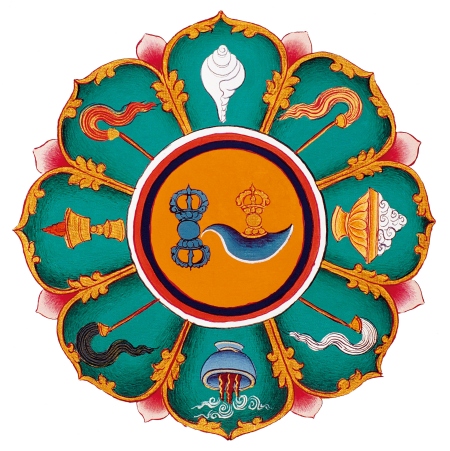Emblems of the deities
Mind palace
In the following notes, seed-characters from the Vimalaprabhā are given for completeness;
the Vajrāvalī only lists the emblems. C: refers to the centre. Click on images for higher resolution versions.
On the receptacle of the central lotus is a seat of stacked: white moon,
red sun, black
rāhu and red kālagni. On the lotus receptacle and its petals are:
| |
| C: | blue | huṃ | three-pointed vajra | Kālacakra | (dus kyi 'khor lo) |
| E: | black | a | censer | Kṛiṣṇadīptā | (nag mo 'bar ma) |
| SE: | black | ha | chowry | Dhūmā | (du ba ma) |
| S: | red | aḥ | lamp | Raktadīptā | (dmar mo 'bar ma) |
| SW: | red | haḥ | chowry | Marīcī | (smig rgyu ma) |
| W: | yellow | ā | conch | Pītadīptā | (ser mo 'bar ma) |
| NW: | yellow | hā | chowry | Pradīpā | (mar me ma) |
| N: | white | aṃ | divine food | Śvetadīptā | (dkar mo 'bar ma) |
| NE: | white | haṃ | chowry | Khadyotā | (me khyer ma) |
| |
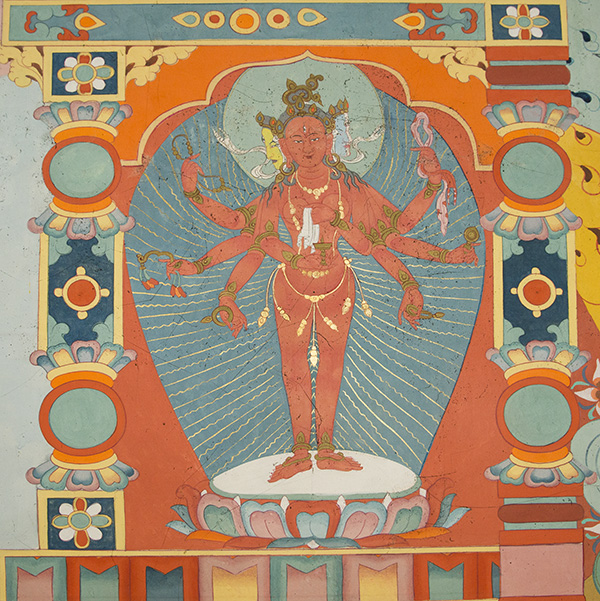 |
Raktadīptā
(Tsangwa Monastery, Dzamthang) |
|
Just outside the central lotus, in the corners formed by the inner beams of the
tathāgata-dais, are four emblems:
SE: black wish-fulfilling jewel
SW: red dharma-semantron
NW: yellow wish-granting tree
NE: white dharma-conch
The next set of deities are the buddhas and their consorts, and they have between them a
set of eight flasks. These are positioned right and left of the buddhas; there are also
two further flasks, for above and below. These are placed in the east and west doorways,
just beyond the lotuses for the wrathful deities.
The buddhas and their consorts are in the cardinal and intermediate directions of the
tathāgata-dais, between the pillars. The lotuses in the cardinal directions are white with
sun (red) seats, and those in the intermediate directions red with moon (white) seats:
| E: | black | i | sword | Amoghasiddhi | (don yod grub pa) |
| SE: | black | ī | blue utpala | Tārā | (sgrol ma) |
| S: | red | ṛi | jewel | Ratnasambhava | (rin chen 'byung ldan) |
| SW: | red | ṛī | lotus | Pāṇḍarā | (gos dkar mo) |
| W: | yellow | ḷi | wheel | Vairocana | (rnam par snang mdzad) |
| NW: | yellow | ḷī | wheel | Buddhalocanā | (sangs rgyas spyan ma) |
| N: | white | u | lotus | Amitābha | (snang ba mtha' yas) |
| NE: | white | ū | utpala | Māmakī | (mā ma kī) |
| |
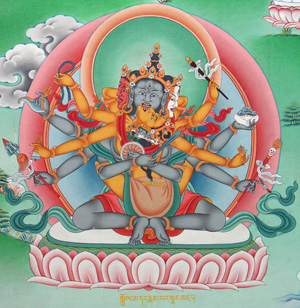 |
| Black Tārā with yellow Vairocana |
|
Next are the male bodhisattvas and their consorts, on the deity-podium of the mind
palace. These all are on white lotuses with sun seats except the two left of west (L of W)
and left of north which are on red lotuses and moon seats:
| L of E: | blue | aṃ | vajra | Samantabhadra | (kun tu bzang po) |
| R of E: | black | e | sword | Khagarbha | (nam mkha'i snying po) |
| SE: black | ai | cloth | Sparśavajrā | (reg bya rdo rje ma) |
| L of S: | green | a | vajra | Vajrapāṇi | (phyag na rdo rje) |
| R of S: | red | ar | jewel | Kṣitigarbha | (sa'i snying po) |
| SW: | red | ār | bowl of supreme flavour | Rasavajrā | (ro rdo rje ma) |
| L of W: | green | ā | dharmodaya | Dharmadhātuvajrā | (chos khams rdo rje ma) |
| R of W: | yellow | al | wheel | Nīvaraṇaviṣkambhin | (sgrib pa rnam sel) |
| NW: | yellow | āl | conch of perfume | Gandhavajrā | (dri rdo rje ma) |
| L of N: | blue | aḥ | vīna | Śabdavajrā | (sgra rdo rje ma) |
| R of N: | white | o | lotus | Lokeśvara | (jig rten dbang phyug) |
| NE: white | au | mirror | Rūpavajrā | (gzugs rdo rje ma) |
| |
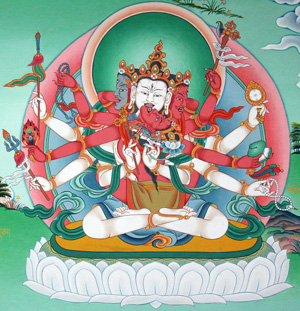 |
| White Lokeśvara and red Rasavajrā |
|
Next are the wrathful deities in the doorways of the mind palace. In the east and north
these are on white lotuses and sun seats; in the south and west on red lotuses and moon
disks:
| E: | black | yaṃ | sword | Atibala | (shin tu stobs) |
| S: | red | raṃ | club | Jambhaka | (rmongs byed) |
| W: | yellow | laṃ | hammer | Stambhaka | (rengs byed) |
| N: | white | vaṃ | lotus | Mānaka | (nga rgyal byed) |
| |
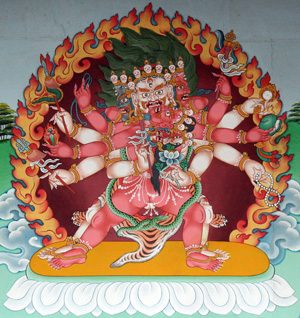 |
| White Padmāntaka (Mānaka) and Jambhakī |
|
The available editions of the Vajrāvalī have these last two emblems the other way
around, with lotus in the west and hammer in the north. This seems to be a mistake. (SG:
There is an extra lotus in the eastern doorway for a fifth wrathful.)
Finally, for the mind palace, there are the offering goddesses on the plinth:
| |
| L of E: | black | cchjjhña | conch (containing perfume) | Gandhā | (dri chab ma) |
| R of E: | black | cchjjhñā | garland of blue flowers | Mālā | (phreng ba ma) |
| L of S: | red | ṭṭhḍḍhṇa | bowl of incense | Dhūpā | (bdug spos ma) |
| R of S: | red | ṭṭhḍḍhṇā | lamp | Dīpā | (mar me ma) |
| L of W: | yellow | tthddhna | head ornament | Lāsyā | (sgeg mo) |
| R of W: | yellow | tthddhnā | jewelled necklace | Hāsyā | (bzhad ma) |
| L of N: | white | pphbbhma | (bowl of) fruit | Amṛitā | (bdud rtsi ma) |
| R of N: | white | pphbbhmā | bowl of nectar | Halā | (bdud rtsi'i 'bras bu ma) |
| |
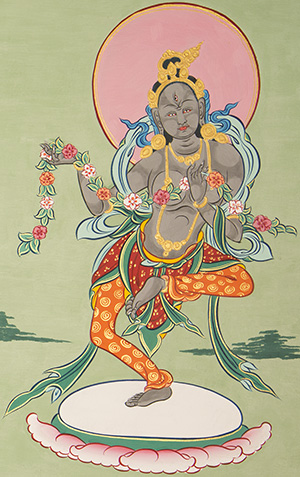 |
Mālā
(Tsangwa Monastery, Dzamthang) |
|
And, in the central cell of each toran in the mind palace:
| E toran: | green | kkhgghṅā | cloth | Nṛityā | (gar ma) |
| S toran: | blue | sḥpṣśḥkā | lotus | Kāmā | ('dod pa ma) |
| W toran: | green | kkhgghṅa | drum | Vādyā | (sgra ma) |
| N toran: | blue | sḥpṣśḥka | vajra | Gītā | (glu ma) |
(SG: Describes using just golden drawing rather than lañca characters to represent these.)
Abhaya adds that the bowls in the north are both skulls and that the west toran drum is a
paṭaha, a traditional Indian kettle-drum, a type usually used for proclaiming some event.
The seed-characters are considered to be stacked. For example, with cchjjhña, the
character ca is on top, below it cha, then ja, jha, and finally ña on the bottom. The
green and blue goddesses are to be drawn in the middle cells of the upper stages of the
torans of the mind palace.
Speech palace
This completes the deities of the mind palace, and we now come to the deities on the eight
lotuses in the speech palace. On each lotus there is a male and female deity (with
the female the chief, facing the centre of the maṇḍala), surrounded by eight yoginīs. On the podium in both the speech and body palaces, the lotuses in the cardinal directions are
red and in the intermediate directions, white. They have neither moon nor sun seats.
Instead, they each have an animal mount, which in this tradition is drawn underneath the
lotus. The same applies to the lotuses of the body palace podium.
In the following, the petals are numbered from the eastern-most petal, clockwise. The
animal mounts under the lotuses are given in brackets. (There are many different names
here from the equivalent list given in the Vimalaprabhā.)
East (red preta):
| C: | black | ha | curved knife | Carcikā | (tsar tsi ka) |
| 1: | black | hi | curved knife | Bhīmā | (jigs byed ma) |
| 2: | black | ya | curved knife | Ugrā | (drag mo) |
| 3: | black | yi | curved knife | Kāladaṃṣṭrā | (mche ba nag mo) |
| 4: | black | yṛi | curved knife | Jvalanmukhā | (kha nas me 'bar ba) |
| 5: | black | hī | curved knife | Vāyuvegā | (rlung shugs ma) |
| 6: | black | yu | curved knife | Pracaṇḍā | (rab gtum ma) |
| 7: | black | yḷi | curved knife | Raudrākṣī | (drag mig ma) |
| 8: | black | yaṃ | curved knife | Sthūlanāsā | (sna sbom mo) |
South-east (garuḍa):
| C: | black | kṣa | wheel | Vaiṣṇavī | (khyab 'jug ma) |
| 1: | black | kṣi | wheel | Śrī | (dpal mo) |
| 2: | black | yā | wheel | Māyā | (sgyu ma mo) |
| 3: | black | yī | wheel | Kīrtti | (grags ma) |
| 4: | black | yṛī | wheel | Lakṣmī | (phun sum tshogs ma) |
| 5: | black | kṣī | wheel | Vijayā | (rnam par rgyal ma) |
| 6: | black | yū | wheel | Śrījayā | (dpal ldan ma) |
| 7: | black | yḷī | wheel | Śrījayantī | (dpal ldan rgyal byed ma) |
| 8: | black | yaḥ | wheel | Śrīcakrī | (dpal 'khor lo ma) |
| South (buffalo): |
| |
| C: | red | haḥ | club | Vārāhī | (phag mo) |
| 1: | red | hṛi | club | Kaṅkālī | (keng rus ma) |
| 2: | red | ra | club | Kālaratri | (dus mtshan ma) |
| 3: | red | ri | club | Prakupitavadanā | (rab tu khros gdong ma) |
| 4: | red | rṛi | club | Kālajihvā | (dus kyi lce ma) |
| 5: | red | hṛī | club | Karālī | (gtsigs ma) |
| 6: | red | ru | club | Kālī | (nag mo) |
| 7: | red | rḷi | club | Ghorā | ('jigs ma) |
| 8: | red | raṃ | club | Virūpā | (gzugs ngan ma) |
| |
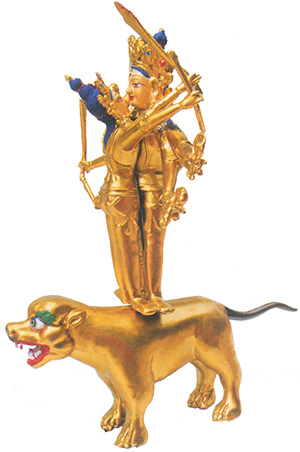 |
Vārāhī
(Tsangwa Monastery, Dzamthang) |
|
South-west (peacock):
| C: | red | kṣaḥ | spear | Kaumārī | (gzhon nu ma) |
| 1: | red | kṣṛi | spear | Padmā | (padma ma) |
| 2: | red | rā | spear | Anaṅgā | (yan lag med ma) |
| 3: | red | rī | spear | Kaumārī | (gzhon nu ma) |
| 4: | red | rṛī | spear | Mṛigapatigamanā | (rigs kyi bdag po'i 'gros ma) |
| 5: | red | kṣṛī | spear | Ratnamālā | (rin chen 'phreng ba ma) |
| 6: | red | rū | spear | Sunetrā | (shin tu spyan ma) |
| 7: | red | rḷī | spear | Līnā | (sdug ma) |
| 8: | red | raḥ | spear | Subhadrā | (bzang mo) |
West (Airāvata, elephant):
| C: | yellow | hā | vajra | Aindrī | (dbang mo)
| | 1: | yellow | hḷi | vajra | Vajrābhā | (rdo rje 'od ma) |
| 2: | yellow | la | vajra | Vajragātrā | (rdo rjei lus can ma) |
| 3: | yellow | li | vajra | Kanakāvatī | (gser ldan ma) |
| 4: | yellow | lṛi | vajra | Urvaśī | (las dbang ma) |
| 5: | yellow | hḷī | vajra | Citralekhā | (ri mo sna tshogs ma) |
| 6: | yellow | lu | vajra | Rambhā | (chu shing ma) |
| 7: | yellow | lḷi | vajra | Ahalyā | (a nya lags ??) |
| 8: | yellow | laṃ | vajra | Sutārā | (shin tu mig 'bras ma) |
North-west (goose):
| C: | yellow | kṣā | mace | Brahmāṇī | (tshangs pa ma) |
| 1: | yellow | kṣḷi | mace | Sāvitrī | (mchod sbyin 'don ma) |
| 2: | yellow | lā | mace | Padmanetrā | (padma can) |
| 3: | yellow | lī | mace | Jaladavatī | (chu skyes can ma) |
| 4: | yellow | lṛī | mace | Buddhi | (blo ma) |
| 5: | yellow | kṣḷī | mace | Vāgīśvarī | (ngag gi dbang phyug ma) |
| 6: | yellow | lū | mace | Gāyatrī | (glu mkhan ma) |
| 7: | yellow | lḷī | mace | Vidyut | (glog ma) |
| 8: | yellow | laḥ | mace | Smṛiti | (dran ma) |
The term mace is used here to indicate the pointed club of Brahma.
North (bull):
| C: | white | haṃ | trident | Raudrī | (drag mo) |
| 1: | white | hu | trident | Gaurī | (gau rī) |
| 2: | white | va | trident | Gaṅgā | (gaṃ gā ma) |
| 3: | white | vi | trident | Nītyā | (gtum ma) |
| 4: | white | vṛi | trident | Tvaritā | (myur ma) |
| 5: | white | hū | trident | Totalā | ('debs ma) |
| 6: | white | vu | trident | Lakṣaṇā | (mtshan nyid ma) |
| 7: | white | vḷi | trident | Piṅgalā | (dmar ser ma) |
| 8: | white | vaṃ | trident | Kṛiṣṇā | (nag mo) |
| North-east (lion): |
| |
| C: | white | kṣaṃ | lotus | Lakṣmī | (phun sum tshogs ma) |
| 1: | white | kṣu | lotus | Śrīśvetā | (dpal ldan dkar mo) |
| 2: | white | vā | lotus | Candralekhā | (zla ba'i ri mo can ma) |
| 3: | white | vī | lotus | Śaśadharavadanā | (ri bong 'dzin zhal ma) |
| 4: | white | vṛī | lotus | Haṃsavarṇā | (ngang pa'i mdog ma) |
| 5: | white | kṣū | lotus | Dhṛiti | ('dzin ma) |
| 6: | white | vū | lotus | Padmeśā | (padma'i dbang mo) |
| 7: | white | vḷī | lotus | Tāranetrā | (skar mig ma) |
| 8: | white | vaḥ | lotus | Vimalaśaśadharā | (dri med ri bong 'dzin ma) |
| |
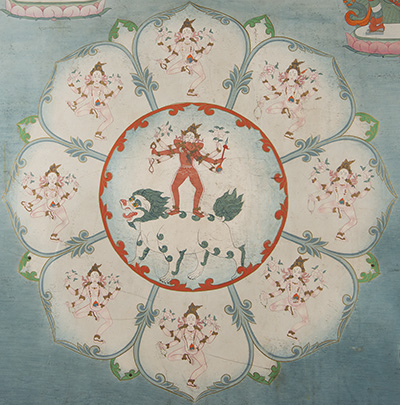 |
Lakṣmī and her retinue
(Tsangwa Monastery, Dzamthang) |
|
(SG: Only gives the animals for the intermediate directions, presumably because the
animals cannot be drawn for the cardinal directions as the lotuses are in the central
cells of the mind toran. The fact that Abhaya gives these animals perhaps suggests the
method of the Vimalaprabhā, in which the animals are on top of the lotus receptacles.)
Body palace and beyond
Next are the deities of the body palace podium. There are 12 lotuses on the podium, each
with 28 petals. On the receptacle of each lotus there is a male and female deity (this
time the male is the chief deity), surrounded by twenty-eight yoginīs.
The ordering of the lotus petals is quite different from the lotuses in the speech palace,
and the structure of the list of characters from which these deities arise is also
different. There are 30 deities in each group, and their seed-characters are a combination
of a group of five consonants with six vowels. For example, on the lotus right of the
eastern door, the set of consonants is: ca, cha, ja, jha and ña. These are combined in
reverse order with the vowels: a, i, ṛi, u, ḷi and aṃ. This produces the following list of 30 characters:
ña, ñi, ñṛi, ñu, ñḷi, ñaṃ, jha, jhi, jhṛi, jhu, jhḷi, jhaṃ, ja, ji, jṛi, ju, jḷi, jaṃ,
cha, chi, chṛi, chu, chḷi, chaṃ, ca, ci, cṛi, cu, cḷi, caṃ.
These represent the 30 lunar days of the month of Caitra, and the deities for the 15th
(full Moon) and 30th (new Moon) lunar days, are respectively the female and male deities
on the receptacle of the lotus. Their characters are jṛi and caṃ. The remaining 28
characters are placed sequentially on the petals of the lotus, but exactly how is not
described clearly in the original literature.
It is usually accepted that the characters are placed in order, first on the eastern petal
of the inner ring of four petals, then proceeding clockwise, moving to the eastern petal
of the middle ring after the inner is complete, and so on. The characters are placed in
the order given above, with dzṛi and tsaṃ omitted as their deities are on the receptacle.
Moving around the podium clockwise, the next lotus is in the south-east, and the vowels
are now long, and combined with the same consonants, but in the normal order:
cā, cī, cṛī, cū, cḷī, caḥ, chā, chī, chṛī, chū, chḷī, chaḥ, jā, jī, jṛī, jū, jḷī, jaḥ,
jhā, jhī, jhṛī, jhū, jhḷī, jhaḥ, ñā, ñī, ñṛī, ñū, ñḷī, ñaḥ.
As before, jṛī and ñaḥ are omitted from the group when placing them on the petals.
For all twelve lotuses:
| L of E: | black | ka kha ga gha ṅa | wheel | Viṣṇu | (khyab 'jug) |
| R of E: | black | ca cha ja jha ña | sword | Nairṛiti | (bden bral) |
| SE: | black | ca cha ja jha ña | wishing tree | Vāyu | (rlung lha) |
| L of S: | red | ka kha ga gha ṅa | vajra-club | Yama | (gshin rje) |
| R of S: | red | ṭa ṭha ḍa ḍha ṇa | lance | Agni | (me lha) |
| SW: | red | ṭa ṭha ḍa ḍha ṇa | spear | Ṣaṇmukha | (gdong drug) |
| L of W: | yellow | sa ḥpa ṣa śa ḥka | jewel or mace | Kubera | (lus ngan po) |
| R of W: | yellow | ta tha da dha na | vajra | Śakra | (dbang po) |
| NW: | yellow | ta tha da dha na | needle | Brahmā | (tshangs pa) |
| L of N: | white | sa ḥpa ṣa śa ḥka | trident | Rudra | (drag po) |
| R of N: | white | pa pha ba bha ma | fetter | Samudra | (rgya mtsho) |
| NE: | white | pa pha ba bha ma | axe | Gaṇeśa | (tshogs bdag) |
| |
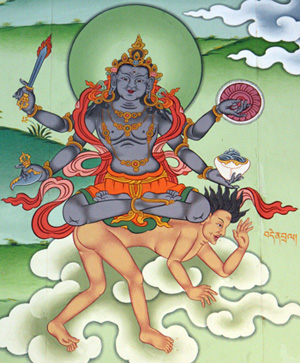 |
| Nairṛiti |
|
Left of west, instead of "jewel or mace" as the text states, we should probably read a
jewel-tipped mace. In traditions for the Kālacakra maṇḍala other than the Vajrāvalī, the
deities LoE and LoS are green and those LoW and LoN blue. The fact that they are here the
colours of their directions is one of the most prominent differences with the Vajrāvalī,
and identification of this feature is the easiest way to recognise a maṇḍala from
Abhayākaragupta's tradition.
The mounts are:
| | |
| R of E: | red preta (SG: flesh coloured) |
| SE: | deer (SG: yellow ) |
| L of S: | buffalo (SG: blue) |
| R of S: | sheep |
| SW: | peacock |
| L of W: | elephant |
| R of W: | elephant |
| NW: | goose |
| L of N: | bull (SG: blue) |
| R of N: | sea-monster (makara, chu srin) (SG: red) |
| NE: | mouse (SG: blue) |
| |
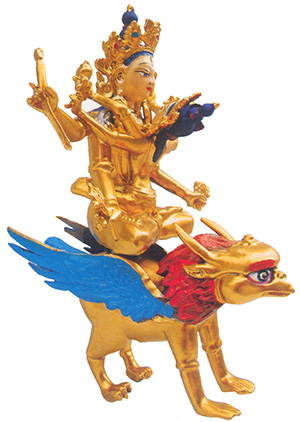 |
Viṣṇu and consort riding on his garuḍa
(Tsangwa Monastery, Dzamthang) |
|
Next are the wrathful deities in the doorways of the body palace, plus one above
and one below, each drawn by seven draught animals. At this point, Abhaya states that the
emblems are placed on lotuses. Four chariots were described earlier for these deities, and
the lotuses will be on the chariots, but what about the other two? He states that the
other two emblems are just beyond those in the eastern and western doorways. There is not
much space to draw them that way, and so some draw the chariots side by side, while others
have the above and below chariots beyond the tops of the eastern and western torans. The
latter method seems the most accepted.
| East door: | black | ya | club | Nīladaṇḍa | (dbyug pa sngon po) |
| South door: | red | ra | arrow | Ṭakkirāja | ('dod pa'i rgyal po) |
| West door: | yellow | la | mace | Mahābala | (stobs po che) |
| North door: | white | va | pestle | Acala | (mi g.yo ba) |
| Above: | green | haṃ | vajra | Uṣṇīṣacakravartī | (gtsug tor 'khor los sgyur ba) |
| Below: | blue | ha | trident | Sumbharāja | (gnod mdzes rgyal po) |
| |
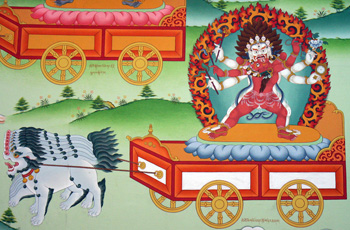 |
| The wrathful Acala |
|
The draught animals pulling these chariots are:
E: boars
S: horses
W: elephants
N: lions
A: three-eyed, five-coloured garuḍas
B: eight-legged lions (śarabha)
The final list of emblems described in the Vajrāvalī are for a group of thirty-six
goddesses ('dod ma, icchās) on the plinth of the speech palace, and an equivalent group of
thirty-six goddesses (phyir 'dod ma/mi 'dod ma, pratīcchās) on the plinth of the body
palace.
Their colours, hand emblems, directions, etc., all match between the two groups, and their
seeds are easily converted between the two. For example the seed of Vidveṣecchā on the speech plinth is caḥ, and of the equivalent Vidveṣapratīcchā on the body plinth is caṃ.
It is with this list of goddesses that one finds the greatest variations between the
different texts and traditions, in the spelling of their names, their emblems, their
positions and their physical descriptions. There is no such thing as a definitive list of
these goddesses.
The icchā goddesses are associated with groups of other goddesses in the maṇḍala:
four buddha consorts, six bodhisattva consorts, four mind palace wrathfuls' consorts, the
eight chief goddesses of the speech palace, the six wrathfuls' consorts on chariots, and,
the eight pracaṇḍā. They are also associated with another group of 36 mātṛikā goddesses in the maṇḍala of 100 yoginīs, which are themselves connected to the 36 professional castes in medieval Bengal.
The list is given here for the icchās of the speech palace. They are described in eight
groups, those to the right and to the left of the doorway, the one nearest to the doorway
first. In the groups of five to the right of each doorway, the last in each list are
considered by some to be on the corners of plinth.
| RoE (all black): |
| |
| utpala | Vidveṣecchā | (zhe sdang 'dod ma) |
| clothing | Amśukecchā | (gos 'dod ma) |
| curved knife | Kāyakaṇḍūyanecchā | (lus 'phrug 'dod ma) |
| wheel | Vadanagatakaphotsarjanecchā | (kha lud 'dor 'dod ma) |
| khaṭvāṅga | Uccāṭanecchā | (skrod 'dod ma) |
| |
| LoE (all black, except one): |
| |
| curved knife | Saṃtāpecchā | (rab tu chab 'dod ma) (blue) |
| sword | Sparśecchā | (reg bya 'dod ma) |
| curved knife | Sarvāṅgakṣepaṇecchā | (yan lag thams cad dkrug 'dod ma) |
| curved knife | Utsṛiṣṭabhaktecchā | (lhag ma za 'dod ma) |
| |
| RoS (all red): |
| |
| lotus | Stobhanecchā | (bstod par 'dod ma) |
| bowl of food | Bhojanecchā | (zas 'dod ma) |
| club | Aṅgamalecchā | (yan lag gi sku mnyed 'dod ma) |
| spear | Nṛityecchā | (gar 'dod ma) |
| lotus | Śoṣaṇecchā | (skam 'dod ma) |
| |
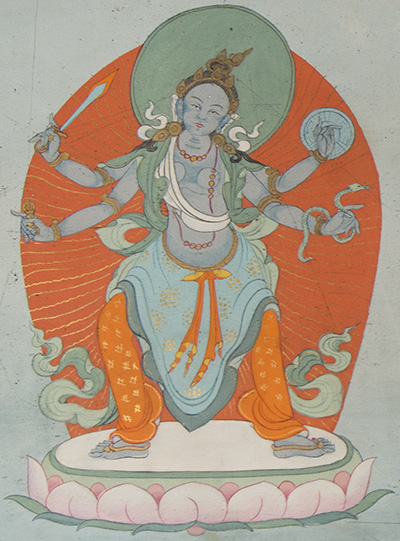 |
Sparśecchā
(Tsangwa Monastery, Dzamthang) |
|
LoS (all red, except one):
| arrow | Ākṛiṣṭīcchā | (logs su 'gugs 'dod ma) |
| axe | Dhāvanecchā | (rgyug 'dod ma) (green) |
| curved knife | Mūtraviṭśamanecchā | (dri chen dri chu spong 'dod ma) |
| curved knife | Saṃgrāmecchā | (g.yul ngo 'dod ma) |
RoW (all yellow):
| wheel | Stambhanecchā | (rengs 'dod ma) |
| perfume conch | Gandhecchā | (dri chab 'dod ma) |
| vajra | Śayanecchā | (nyal 'dod ma) |
| needle | Peyapiplāvanecchē | (chul 'dzul 'dod ma) |
| wheel | Bandhanecchā | (bcings 'dod ma) |
LoW (all yellow, except one):
| dharmodaya | Maithunecchā | ('khrig pa 'dod ma) (green) |
| wheel | Kīlanecchā | (phur bu 'debs 'dod ma) |
| curved knife | Vajranecchā | (slu 'dod ma) |
| curved knife | Ahibandhanecchā | (sbrul gyis bcings 'dod ma) |
RoN (all white ):
| utpala | Puṣṭīcchā | (rgyas 'dod ma) |
| mirror | Bhūṣaṇecchā | (rgyan 'dod ma) |
| trident | Āsanecchā | (gdan 'dod ma) |
| lotus | Rajyecchā | (rgyal po'i srid 'dod ma) |
| utpala | Mṛiduvacanecchā | ('jam par smra 'dod ma) |
LoN (all white, except one):
| vīṇā | Vādyecchā | (sgra 'dod ma) (blue) |
| hammer | Bandhanecchā | (phyag 'tshal 'dod ma)
| curved knife | Bahukalahecchā | (thab mo mang po 'dod ma) |
| curved knife | Dārakakrīḍanecchā | (khye'u la khro 'dod ma) |
(SG: Suggests that the emblems are not drawn, but lañca characters instead.)
Abhaya does not at this point mention emblems for the nāgas or the pracaṇḍas – these were
described earlier. For the sake of completeness, their names and seeds are given here:
Nāgas:
| L of E: | black | hya | victory banner | Karkkoṭa | (stobs kyi rgyu) |
| R of E: | black | hyā | victory banner | Padma | (padma) |
| L of S: | red | hra | svastika | Vāsuki | (nor rgyas) |
| R of S: | red | hrā | svastika | Śaṅkhapāla | (dung skyong) |
| L of W: | yellow | hla | vajra | Takṣaka | ('jog po) |
| R of W: | yellow | hlā | vajra | Mahāpadma | (padma chen po) |
| L of N: | white | hva | lotus | Ananta | (mtha' yas) |
| R of N: | white | hvā | lotus | Kulika | (rigs ldan) |
| Above: | green | huṃ | flask | Jaya | (rgyal ba) |
| Below: | blue | kṣuṃ | flask | Vijaya | (rnam par rgyal ba) |
| |
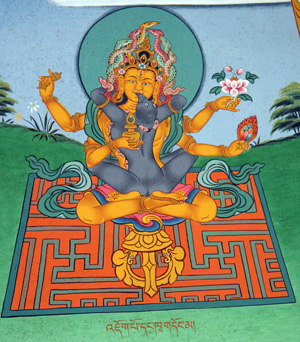 |
The yellow nāga Takṣaka
with black Kākāsyā |
|
Pracaṇḍās (all emblems are curved knives):
| E: | black | kkhgghṅa | Śvānāsyā | (khyi gdong ma) |
| SE: | black | cchjjhña | Kākāsyā | (khwa gdong ma) |
| S: | red | lvrykṣa | Śūkarāsyā | (phag gdong ma) |
| SW: | red | ṭṭhḍḍhṇa | Gṛidhrāsyā | (bya rgod gdong ma) |
| W: | yellow | sḥpṣśḥka | Jambukāsyā | (ce spyang gdong ma) |
| NW: | yellow | tthddhna | Garuḍāsyā | (mkha' lding gdong ma) |
| N: | white | lvryha | Vyāghrāsyā | (stag gdong ma) |
| NE: | white | pphbbhma | Ulūkāsyā | ('ug gdong ma) |
| A: | green | ha | Anīlā | (sngon mo) |
| B: | blue | haḥ | Vajrākṣī | (rdo rje mig can ma) |
| |
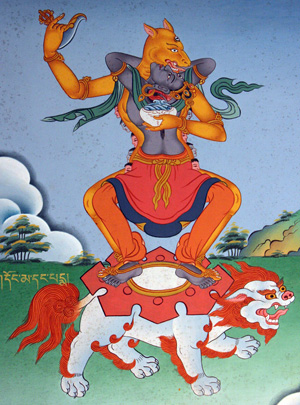 |
| The pracaṇḍā Jambukāsyā |
|
In the Vajrāvalī's companion text, the Niṣpannayogāvalī (rdzogs pa'i rnal 'byor gyi phreng ba), Abhaya has these last two on chariots, rather than the disks of
emptiness as described earlier. (SG: Has here two wheels in both the east and west; they
all have eight-petalled lotuses on their hubs, and have no animal seats.)
If the animal mounts are drawn underneath the wheels, they are:
| |
| E: | rhinoceros |
| SE: | bheruṇḍa (a yellow bird) |
| S: | bear |
| SW: | crane |
| W: | lion |
| NW: | nīlākṣa, (a blue bird) |
| N: | yak |
| NE: | bat |
| |
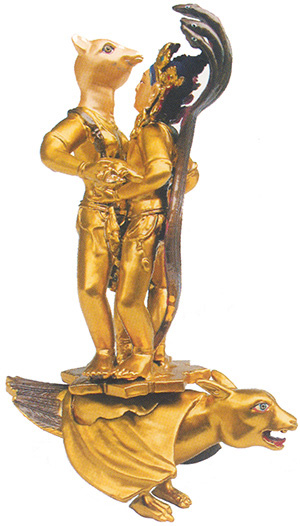 |
NE: Ulūkāsyā – she is on the left;
her nāga consort is on the right |
|
The final emblems that need to be mentioned are those of the perimeter beings in the
perimeter of wind (or more usually on the border between the wind and fire perimeters).
These are not given in the Vajrāvalī but are mentioned in the
Niṣpannayogāvalī. This first gives the position of the planets, each on disks of elements.
It simply names them, without giving any emblems or seeds.
E: wind – Moon
SE: wind – Sun
S: fire – Mercury
SW: fire – Mars
W: earth – comet (mjug rings)
NW: earth – Saturn
N: water – Venus
NE: water – Jupiter
A: space – Rāhu (sgra gcan, Moon's ascending node)
B: space – Kālāgni (dus me, descending node)
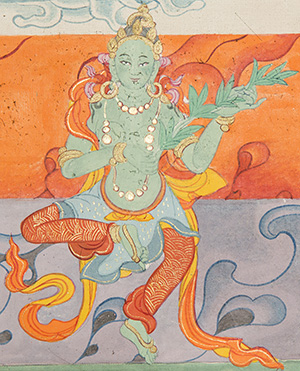 |
Dūtī, representing the messengers
(Tsangwa Monastery, Dzamthang) |
The text then simply names some of the other perimeter beings: Dhruva (the Pole Star),
Agastya (presumably Canopus), the 28 lunar mansions, the 12 signs of the zodiac, the 16
phases (of the Moon), the worldly protectors of the 10 directions, Nandi (dga' ba
can), Mahākāla (nag po chen po), Ghaṇṭākarṇa (dril bu'i rna ba can),
Hāriti ('phrog ma), Bhṛṅgī (nyam chung), and large numbers of field
protectors (kṣetrapāla, zhing skyong), messengers (dūtī, pho nya), and
siddhas (grub pa).
No particular instructions are given, and so an artist would represent as many of these as
seems appropriate, with different colours, emblems, and so forth. However, two traditions
have been developed in Tibet for these beings to be represented by specific
seed-characters between the charnel grounds - a total of 88 developed by Buton, used for
example in the Gelug tradition, and a total of 112 used in the Karma Kagyu tradition.
These traditions are both described on this web page.
This completes the decription of the Kālacakra maṇḍala from the Vajrāvalī.
|
